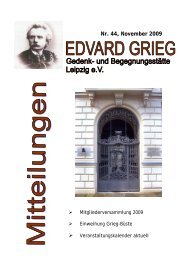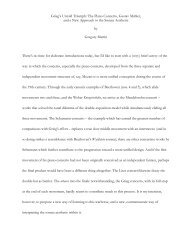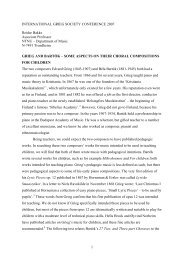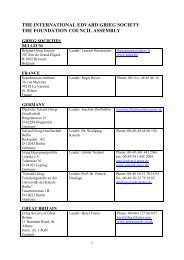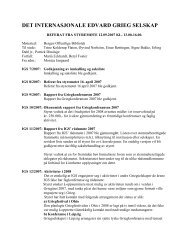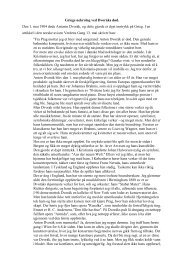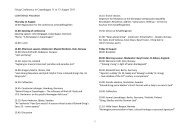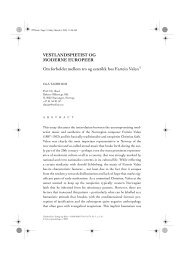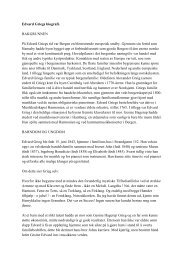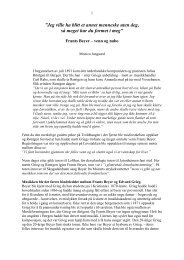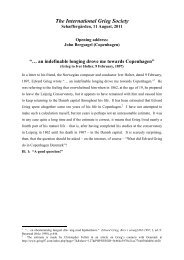Gregory Martin - paper 2007 - Grieg Society
Gregory Martin - paper 2007 - Grieg Society
Gregory Martin - paper 2007 - Grieg Society
You also want an ePaper? Increase the reach of your titles
YUMPU automatically turns print PDFs into web optimized ePapers that Google loves.
more Nordic than Germanic), 3 and the national language was seen as a link to the<br />
extraordinary past in which these tales played out. In this context, it is my purpose to<br />
submit that it was <strong>Grieg</strong>’s dramatic collaborations with riksmål devotee Bjørnstjerne<br />
Bjørnson that most immediately left their mark on his most profound work for solo<br />
piano—the Ballade in G minor, Op. 24 (1875-6)—and that the source of those<br />
collaborations lead to the unique poetics of this work, making it <strong>Grieg</strong>’s contribution to<br />
the great tradition of the Norse epic.<br />
* * *<br />
In a letter to composer and conductor Iver Holter (1850-1941) dated 9 February 1897,<br />
<strong>Grieg</strong> wrote: “It is a sacred duty for me to call attention to the great influence that my<br />
association with Bjørnson from the autumn of 1866 to the spring of 1873 had on my art.<br />
He formed my personality in countless ways—that is to say, he contributed mightily to<br />
that process.” 4 And of those eight years or so, the final three were particularly productive,<br />
yielding no less than five major dramatic works. Whether written as a setting of an<br />
already completed poetical work or through cooperation with the author, each of these is<br />
based on the Norse sagas or saga themes, and it is of no small significant for my<br />
argument vis-à-vis the Ballade (1875) that these collaborations all occurred between<br />
1871 and 1873:<br />
● 1871, Foran Sydens kloster, Op. 20—text taken from Bjørnson’s epic cycle<br />
Arnljot Gelline, the namesake of which is a character in the saga of St. Olav (Olav<br />
Haraldsson) by Snorri Sturluson<br />
3 Also to be mentioned in this context is the new value that the fairy-tale took on as a tool to stroke<br />
nationalist sentiment: P. C. Asbjørnsen and Jørgen Moe in Norway, Hans Christian Andersen in Denmark,<br />
and the Grimm Brothers in the German states, to name a few.<br />
4 <strong>Grieg</strong>, Letters, 419.<br />
2



